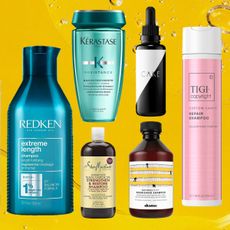
Humor writer David Sedaris was going for the laugh when he dubbed his aggressively sun-kissed sister a "tanorexic" in his 2000 memoir, Me Talk Pretty One Day, as if her greatest affliction were vanity. Now part of the modern lexicon, the term clearly and aptly evokes "anorexia" — which is no laughing matter. Undeterred by skyrocketing skin cancer statistics (the most common cancer affecting women ages 25 to 29) and UV's indisputable aging effects, tan extremists chase the sunbaked look 365 days a year.
"Until five years ago, I didn't pick up sunblock," admits Katherine Bell, 30, a grad student from Pittsburgh, who favored baby oil instead. Even when her husband called out her "fried to a crisp" face after a week in the Bahamas, "it took years to modify my psychotic bronzing behavior. The rush I got from tanning was 100 percent addictive."
This rush is just what the latest medical findings are confirming: that frequent tanning is akin to a drug addiction. Found in sunlight and tanning beds, ultraviolet light (made up of UVA and UVB rays) in fact produces endorphins — chemicals in the brain that create a feeling of euphoria. Researchers at Wake Forest University Baptist Medical Center studying frequent tanners who'd been given endorphin blockers recorded withdrawal symptoms — namely nausea, dizziness, and the shakes.
Addiction is why tanorexics can't simply slather on self-tanners — just as chain-smokers can't be cured with a stick of gum. Come winter, rather than give up their drug, sunheads (70 percent of them are Caucasian women, ages 16 to 49) hit the tanning salon — which is even more dangerous than overdoing it outdoors. "Tanning lamps emit four times more damaging UVA rays than the sun," explains Manhattan dermatologist Dr. Jody A. Levine. What's more, your risk of melanoma (the most deadly skin cancer) increases 75 percent if you tan indoors before age 35.
"Addicts live in constant fear of fading," notes Dr. Amy Wechsler, MC's "beauty shrink" and a dermatologist and psychiatrist in New York. "Suddenly they feel fatter, older, even sicker. It explains the extremes they go to to keep it up." Mei Lei Leong, a 37-year-old marketing executive, recalls sunbathing in a bikini on the first sunny day of spring, "no matter how cold it was." Lauren Smith, a writer who once tanned indoors four times weekly, points to the fashion factor: "I feel sexier in clothes when I'm tan." And she's not alone, judging from the number of top designers (particularly in Italy) whose natural skin tone we've never known.
But even addicts can occasionally be scared straight. Michael Kors, whose bronzed skin is synonymous with his upscale brand, recently declared that he's switching to self-tanners after discovering a basal-cell carcinoma on his face. "I've cooked my whole life at the beach, but I've learned my lesson," Kors ruefully told the press last April.
"There should be a 12-step program for tanners," suggests Wechsler. "They need to be treated like other addicts." In the short term, switching to a self-tanner is a step in the right direction. "I finally gave up the tanning bed," says Smith. "But I still need the color. So now I have a standing weekly spray-tan appointment."
Stay In The Know
Marie Claire email subscribers get intel on fashion and beauty trends, hot-off-the-press celebrity news, and more. Sign up here.
-
 Zendaya Warms Up for the Met Gala in a Rare Vintage Dress
Zendaya Warms Up for the Met Gala in a Rare Vintage DressShe addressed the night's theme in two ways at once.
By Halie LeSavage Published
-
 Kate Beckinsale Says Never-Ending Claims She's Had "Unrecognizable Surgery" is Taking a "Toll"
Kate Beckinsale Says Never-Ending Claims She's Had "Unrecognizable Surgery" is Taking a "Toll""...it happens constantly and it’s usually women that are doing it."
By Danielle Campoamor Published
-
 Eva Mendes Shares Sweet Post in Support of Ryan Gosling and His New Movie
Eva Mendes Shares Sweet Post in Support of Ryan Gosling and His New Movie"Do you believe in happy endings?"
By Danielle Campoamor Published
-
 Why Beauty Experts Are Calling Out Youthforia's New Foundation
Why Beauty Experts Are Calling Out Youthforia's New FoundationThis isn't the way to do inclusive shades.
By Halie LeSavage Published
-
 The 32 Best Hair Growth Shampoos of 2024, According to Experts
The 32 Best Hair Growth Shampoos of 2024, According to ExpertsRapunzel hair, coming right up.
By Gabrielle Ulubay Published
-
 The 20 Best Hair Masks for Damaged Hair, According to Experts and Editors
The 20 Best Hair Masks for Damaged Hair, According to Experts and EditorsHealthy strands, here we come!
By Gabrielle Ulubay Last updated
-
 How Often You Should Wash Your Hair, According To Experts
How Often You Should Wash Your Hair, According To ExpertsKeep it fresh, my friends.
By Gabrielle Ulubay Published
-
 The 11 Best Magnetic Lashes of 2023
The 11 Best Magnetic Lashes of 2023Go ahead and kiss your messy lash glue goodbye.
By Hana Hong Published
-
 Beauty Advent Calendars Make the Perfect Holiday Gift
Beauty Advent Calendars Make the Perfect Holiday GiftThe gift that keeps on giving.
By Julia Marzovilla Last updated
-
 The 18 Best Natural Hair Products in 2023
The 18 Best Natural Hair Products in 2023Remember: Your curls are your crown.
By Gabrielle Ulubay Published
-
 The 9 Best Hot Rollers for the Curls of Your Dreams
The 9 Best Hot Rollers for the Curls of Your DreamsThis is how we roll.
By Samantha Holender Published